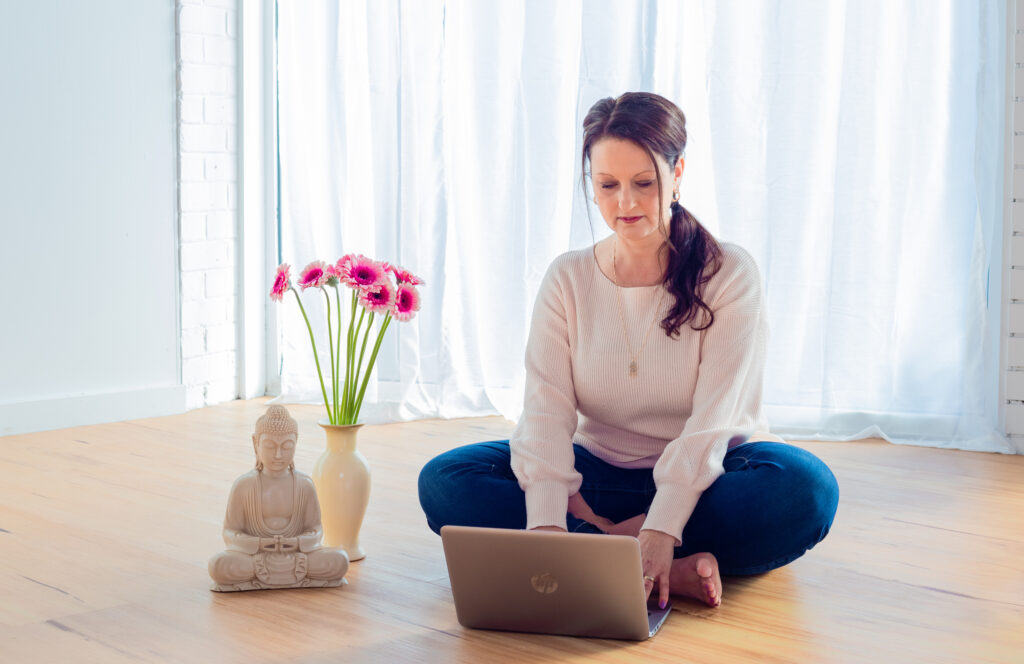
by tanyafrancois | Feb 23, 2021 | Mental Health
Many of us struggle with self-compassion. I personally view myself as a compassionate person, but self-compassion is something I have struggled with, in my own life. I’ve had to learn the skills of how to be kind and compassionate towards myself.
Self-compassion takes practise, patience and perseverance, to perfect your skills. Once you master the skill of self-compassion, you unveil a beautiful masterpiece within yourself
So how do we start creating our masterpiece within ourselves?
As I mentioned, many of us view ourselves as compassionate people. It’s easier to treat others with compassion, kindness and warmth. However, many of us can struggle to treat ourselves with the same compassion.
What is self-compassion?
Self-compassion is a mindfulness technique. It is the ability to acknowledge your own, thought, feelings and responses with understanding acceptance and kindness towards yourself
In other words, treating yourself the same way you would treat a good friend who is experiencing painful emotions. Think about how you would treat that friend. I am sure you would be warm, caring, kind and compassionate, towards them.
However, if you were in the same emotional pain. Could you extend the same compassion and love towards yourself? Are you able to acknowledge your plain and hold yourself in a kind, caring, warm, and compassionate way?
It is not always easy to show ourselves compassion. When we are in pain, we offend treat ourselves with harshness unkind word, judging and criticizing ourselves. The inner critic’s loves to show up when we make a mistake, fail at something or feel stressed and overwhelmed.
When the inner critic overwhelms us with judgement, harsh words, and negativity, it is easy to miss the point of self-compassion. We invalidate our emotions by telling ourselves: We should not feel this way. We should not have these thoughts. Our mind tells us we should not act like this. We call ourselves unkind names. We repeated the “I am not good enough” story over and over again.
Does it sound familiar to you? We can be so harsh and critical of ourselves. Invalidating our experiences, thoughts, feeling and emotions. When we are overcome by difficult thoughts or feelings. This is the perfect time to learn how to show ourselves more self-compassion.
Many of us have little or no experience with self-compassion. Often when we told about self-companion, we find it threatening self-indigent or overwhelming.
The fact is that self-compassion has so many positive effects on every aspect of our lives.
Over the last decade, research has consistently shown a positive correlation between self-compassion and well-being
That including:
- Boost to happiness
- Improved self-imagine
- Self-worth
- Resilience
- Reduce stress
- Improved mental health
How do we start taking the steps to develop self-compassion?
The concept of self-compassion may feel unfamiliar and uncomfortable at first. If you are embarking on this self-compassion journey for the first time. Start by building self-compassion through small steps.
Do not allow yourself to be threatened and overwhelmed by the inner critic telling you it’s too hard.
Stop and reflect for a moment: “We have been criticizing ourselves for years and it has not worked. Let’s try something different. Try showing yourself approve, compassion and kindness and see what happens”
Take your time and be gentle with yourself. Here are some tips to get you started with self-compassion.
Understanding the relationship with the Inner critic.
Most of us are familiar with the inner critic. That voice in our mind is quick to judge and citizen us. The inner critic seems to enjoy the opportunity to highlight our mistakes, flaws, and failures.
Making us feel that we cannot measure up to the expectation, we place on ourselves. We replay the “never good enough” story on repeat in our mind. The relationship we have with our inner critic gives us the opportunity to start taking the first steps to developing self-compassion. We can learn how to release the “I’m not good enough story”, self-judgment and harsh words of the inner critic.
This is one of the most important steps towards self-compassion.
The first step is we need to become aware of the stories we tell ourselves. We can do this by, noticing and naming the story our inner critic is telling us. Then we can teach start ourselves how to disengage from the inner critic.
We do this by seeing the inner critics as nothing more than words and pictures, our mind is showing us. We do not need to get into a discussion with ourselves about whether it’s true or false. We can show ourselves self-compassion. By letting the thoughts and pictures of the inner critic come and go in their own time. We do not need to be pushed around by the inner critic. We can show ourselves kindness and compassion in the storm of the inner critic by:
Talk to ourselves in a caring gentle and understanding way.
Try this: Notice and Name the Story
- This week start to notice the story you tell yourself.
- You may want to write down the words you say to yourself.
- The next step- is to name the story eg, (There is the “I’m not good enough story).
- By giving the story a name, it gives you more power. Realising it’s a story, it does not mean it is true or false. It’s only words and you can choose how much power you give those words.
- Let go of the story if it is unkind.
- Put your hand on your heart. Take some deep breaths. Release the words and show yourself kindness and compassion.
Only through practice and patience, do we become better at showing ourselves compassion. Next time the inner critic shows up and starts judgement and using harsh words. Take a moment pause and notice and name the story. Remember self-compassion is showing yourself the same kindness you would show a friend or loved one in pain. You are worthy of love, you are worthy of kindness, and most of all you are worthy of self-compassion. Start mastering the skill of self-compassion and unveil that beautiful masterpiece that is within you.
Are you ready to start taking the first steps to show yourself self-compassion?
I would love to hear how you feel about this topic and how you are bringing more self-compassion into your life. Please comment and share your experience
Do you feel inspired to start your journey of self-compassion? Please click here for more information about how I can help you with self-compassion. It is one of my favourite things to teach. If you have any questions please feel free to get in touch

by tanyafrancois | Jan 22, 2021 | Mental Health
Recent events have touched us all in a deep and profound way. We have been forced to slow down and withdraw from our fast pace way of life.
The life we once knew of filling every minute of every day with busy busy … came to a grinding halt.
Without the busyness to fill our every waking moment. It gives way to more time and space to go within and explore a little deeper.
For me, this time has made me question, contemplating and reflecting. I guess you could call it self-reflection, trying to understand the internal struggle of thoughts, feelings, and emotions. Questing my place in the world, am I on the path a want to be on? I am I following my dreams. Where do I fit in? What do I have to offer? All these questions have been a wakeup call. It has given me the opportunity to look in the mirror and ask myself the important questions about my life. This time has allowed me to embark upon the journey of self-reflection.
Are you ready you to go on your own journey of self-reflection?
Self-reflecting is not necessarily an easy journey to face. However, I will promise you this. It is one of the most valuable journeys; you will undertake for your personal growth.
“The Journey into self-love and self-acceptance must begin with self-examination… until you take the journey of self-reflection it is almost impossible to grow or learn in life” (Iyanla Vanzant)
Self-reflection is the process of taking the time to go within and analyse our inner self a little deeper. Through this analysing we able to gain insight into who we are, what we value, out thoughts, actions, desires and motivation.
In this self-reflective process, we come to understand our true selves. By looking inward, we tale off the mask we wear for the outside world. It allows us to connect with our true selves and grow from this self-reflection experience. Self-reflection is a powerful process and it will have a positive effect on your life.
Let’s go on a journey of self-reflection
Here are ten practices that will help you go within and self-reflect.
1.Write
Journaling for self-reflection
Journaling is a beautiful way to deeply self-reflection.
It can be as simple as writing a daily self-reflection sentence about anything you want to reflect on.
Another way to journal is to reflecting daily on three things you are grateful for and why.
If you feeling you want to go a little deeper. Then write a longer journal entry about something good or bad that you experienced.
Explore and reflect about the event, your thoughts feelings or emotions that are coming up for you.
Try not to censor what you write, allow the words to flow. Then read over your journal entry. Reflect upon what you have written, you will be amazed about the insight you get from your writing.
There no wrong or right way to journal. do what feels right for you and will help you to reflect inwards
2. Question Yourself
Asking yourself the tough questions is a vital part of the self-reflective These questions can feel uncomfortable, however, by asking these questions and answering honestly, we able to hold a reflective mirror up to your lives and yourself.
Reflective questions:
Who am I?
How I am I behaving?
What are my values?
What are my desires?
Is my life heading in the direction I want?
What motivates me?
What makes me happy?
3. Cultivating time for Stillness
Do you make time in your day for stillness?
As it only from being still and silent. We are able to go within and deeply connect with ourselves and reflect. With stillness, we get to know our true selves. We take a deep inward journey and slowly peel away the lays. There is nowhere to hide in stillness. You are complete with yourself. Disconnected from the external world that distracts us from our true selves.
Reflect:
How can you cultivate time for stillness? It can be a simple as a 5-minute mindfulness practice being still and present in the moment.
Or a beautiful meditations practice. That brings you into stillness
Here are some mediations have created to get you started click here
By creating time to be still it allows the space to do the deep reflective work we need to connect, grow and learn about ourselves
4. Get in touch with your feelings-
Reflect on your feelings and get in touch with how you feel. This is confronting work. For many of us, it is easier to push our feeling aside or tell ourselves that what we are feeling is not valid. Do not dismiss how you feel. You have the right to feel the way you feel and not to push your feelings aside.
By reflecting on feelings, and understanding them. It gives insight into your emotional and mental wellbeing.
Try this practice:
Take a breath
Pause
Reflect:
Go within and ask how do I feel?
Why am I having these feelings?
How are these feeling affecting me?
If you need support with exploring your feeling, more. Enlist the help of a professional counsellor or coach.
5. Reflect on the story
Reflect on the story you are telling yourself. The inner critic what is it saying?
By reflecting on the story and the words, we say to ourselves. It helps to develop inner awareness. Generally the default story we tell ourselves it the I’m not good enough story.
Reflect:
Listen to what it is you say to yourself. Do you need to release the old story or harsh words you speak to yourself?
Stepping back and observing the story gives you the power to defuse the thought pattern. Develop a regular reflective practice of the stories and words you use. It will empower you to recognise when the story is no longer serving you and to replace it with the new and improved story.
6. Care for self
One of the best ways to care for yourself is to reflect on what your needs are and how you care for yourself
Reflect: .
How do I currently care for myself?
Do I spend more time caring for others than myself?
What do I need to feel cared for?
What do I need to feel my best?
Then from the answer to these questions create a care plan for yourself. A great way to put in place your plan, is to pick a time and day that you are committed to implementing care for yourself. I like to have time on Sundays. I call it my self-care Sunday!
7. Self-compassion and kindness.
Did you know that being kind to yourself has a great positive effect on your life? Think about it the way you treat yourself influences every aspect of wellbeing. We are with ourselves 24/7 and we can say some unkind thing to ourselves. Would you say to a friend the thing you say to yourself? The words we say to ourselves have meaning.
Reflect: Do I treat myself with kindness and compassion?
Do I need to be kinder to my self?
Try this : saying something that facilities kindness.
Phrases such as “I am kind to myself” “I am gentle with myself “. I treat myself with kindness.
Place you hand on your heart and say I hold myself with kindness and compassion. Experiment and reflect on what feels good and brings up a feeling of self-compassion.
8. Personal Growth
Do you ever stop and look at how much you have grown? The lessons you have learned along your journey. By self-reflecting on your personal growth, it gives you a picture of where have you been and where are you going.
I am sure along the way there has been mistakes and challenges. However, think about all that you have gained from these experiences.
Reflect on: How much growth you have achieved
Reflect on the personal growth that has taken place over the last 5 years. What have you done? what have you achieved?
An important thing to look at is what learning has taken place from the challenges or mistakes I have made?
Growth can only come about from reflecting in where you once were to where you are today.
9. Permission to Dream
Do you give yourself permission to dream?
Dreams are important. They give your life purpose, direction, goals and meaning for your life.
Reflect upon the dream you are holding. What life do you want to create in the future.? Having a dream to look forward gives you a sense of hope, control and choice about your future.
Don’t give up on your dreams. By giving up on your dream, you are giving up on yourself. Give your self permission to dream and pursue the life you desire.
Reflect:
Do you have a dream? Do you think you are worthy of your dream?
Are you ready to give you self-permission to pursue your dream?
10. Holistic reflection
The connection between mind, body, emotions and spirit has been proven scientifically.
We are more than our thoughts. There is an undeniable connection between mind, body, emotion, and spirit. This holistic connection makes us who we are.
Reflect:
How do I care and connect with:
My mind?
My Body?
My emotions?
My spirituality?
Reflecting on the relationships, we have with the emotional, mental, physical, and spiritual self. Allows us to nourish and connect with ourselves fully.
You may want to choose one self-reflection practice and try each day over the next 10 days.
The journey of self-reflection has so many benefits for our personal growth. Taking time for self-reflection can be difficult and challenging. It is confronting to step back and reflect on yourself. Yet, there are so many benefits of self-reflection. It allows you to connect with yourself, gain perspective, lean and grow.
Wishing you all the best on your self-reflective personal growth journey.
If you curious about diving deeper into self-reflection you can learn more here






